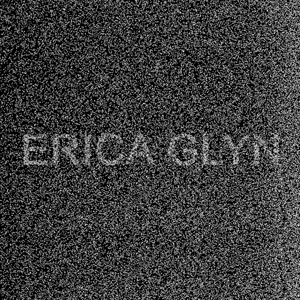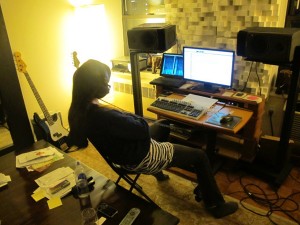On the Record: Erica Glyn “Static”

WILLIAMSBURG, BROOKLYN: Slip into the musical continuum, and you’ll find yourself streaming ahead with Erica Glyn. But exercise caution when absorbing her densely engaging new album, Static – this is an audio solider you’re dealing with, one who will sound off using any means necessary.
Even the most dedicated band member catches themselves thinking…about what would happen if they dropped democracy to pursue their own unilateral vision. With the 10 songs of Static, the Brooklyn-based Glyn has done just that: She deliberately took leave of groupthink to proclaim artistic independence, and create an adventurous nebula of trip hop, acoustic instruments, programming, distortion, alluring vocals and deadly serious hooks.
Beyond songwriting, Glyn’s deep experience as an audio engineer had no small part in producing Static. A disciple of Bob Power, Glyn sharpened her chops working with the NYC mixmaster on projects for the likes of India.Arie, The Roots, Ozomatli, Citizen Cope, and Meshell Ndegeocello. All the better to mix it with, as Glyn consciously turned standard moves upside down to merge the enveloping tracks of Static in her home studio.
For any artist, producer, or engineer looking to bust out, Static serves as an example: If you don’t like the rules, it might be time to write your own.
Erica, you said that the making of “Static” was quite intentionally a dictatorship. How was this in contrast to your previous records, and why did you feel the need to rule Static with an iron fist?
In the past, I’ve been a part of bands where I was the leading force in it, the songwriter and the singer etc…, but there was always a mock-democracy thing happening. I always wanted to play in bands and to collaborate, but in retrospect, those mock-democracy type situations never ultimately served the music, the productions nor the effectiveness very well. I was always concerned with and/or dealing with personalities — egos — and that was ultimately a distraction from the music, but valuable learning experiences all the same.
With this project, though collaborative, at the end of the day I had veto power and didn’t worry about the work that went into a part or the person who created it, myself included. If it didn’t work for the greater good of the song, it didn’t stay. It seems like an obvious thing, but when you are trying to pacify people, self included, it can be difficult to keep focused.
And at the same time as I was being highly tyrannical, I allowed the musicians to do what they do best. I worked with people that I knew I could give guidance to, while simultaneously giving them the freedom to put themselves into it. And I think that comes across in the energy of the music. For example, Leron Thomas who played trumpet on “Animal” came in to play a part that I had written out for him. Afterwards, I asked him to play some fanfare stuff and improvise over the outro. After he did one take, he got inspired and said, “Let me do another one that’ll work with what I just put down.” And then after that he did another one that fit with the previous two takes. It was great and worked perfectly with the track and I didn’t change a thing.
It was the same with Dan Neustadt and his amazing keyboard playing and synth sounds. The intro of “Commonplace” was done in one take. I just told him I wanted the song to start with a memorable hook, and voila! There were other moments that took more crafting on my part, but that was also part of the fun for me. I’ve become pretty good at Pro Tools and have been able to utilize it more like an instrument rather than a recording device.
How else did that outlook go into planning the writing and production of this album? And did everything then go according to plan?
There was no plan. I wrote a bunch of songs in about three weeks, made demos of them and then shared them with musician/producer Brice Malahude who lives in Brussels — we would Skype and file share via FTP. He got inspired and came back at me with a ton of ideas, and I would sift through them picking out what I thought worked best. As those ideas grew, the record unfolded. I worked a bunch at home, studying my Pro Tools maps, cleaning things up, trying things out, really enjoying the process, and enjoying receiving the surprises Brice would leave for me to check out.
Besides doing what I thought would serve the music best, I didn’t have an MO. I tried to let things go where they were going to go, and not try to force anything to work or fit in any direction. If things got scrapped, then they weren’t right or weren’t good enough.
Sounds like a really efficient, but still musical approach. What were the various recording environments? How did they affect the outcomes?
A lot of the record was recorded in my home studio in Williamsburg. A bunch of it was recorded at Brice’s home studio in Brussels – not to mention the pilgrimage he made to Jarno Van Es, somewhere in the countryside of Belgium.
Other than that I worked with Blair Wells at his studio, Purple Velvet, Joel Hamilton in his studio, Studio G, Shahzad Ismaily in his studio, Rivington 66, and drums, trumpet and cello were recorded at The Bunker. Oh, and Nathan Larson sent me tracks from his home studio as well. Blair and I worked at Flux one day to record Casey Benjamin on piano. They have a beautiful Steinway there and the room sounds great.
In terms of how these studio choices affected the sound, well, I think that they all are up to snuff in terms of equipment and technology — but it’s not really about that at the end of the day, is it? I think because most everyone was on their home turf, they felt at ease and excited to play with little pressure and I think that energy — that organic energy — is captured. There was never any belaboring of parts.
How did the mix phase unfold after that?
I ended up mixing the record because I sort of had been mixing it as I was producing it. I was very aware of the sonic spread of the recordings as I was working on them. So I was thinking of instrumentation, parts, melodies etc… as well as the sonics of it. And I had a very clear idea of how things should sound, where they should be placed in the mix, what instruments should be featured when.
There’s a lot in the music – it’s crafted and if you’re not familiar with all the little details that I worked hard to create, moments within moments, well, then they would get lost in the mix. Also, instruments and sounds that traditionally might take the foreground or the background weren’t necessarily taking on their traditional roles, and leaving it in the hands of someone else just didn’t make any sense.
What song or songs are an example of how your mix fulfilled your vision?
For example, in “Commonplace,” both the keys and the electric guitar are strong forces in the verses and they sit in similar registers, so who takes the lead? For me, it’s the electric guitar, hands down. But someone else mixing it might have chosen to feature the keys.
Same with “Polar Shift:” The bouzouki Lyenn played was so beautiful and the recording is pristine, and so it would make sense perhaps to feature it, and have the synth sounds take a far back seat. But that makes no sense to me in the context of the song, the production and how I envisioned it.
Have you always been an audio engineer as well as being an artist? At what point in your career did being an engineer become important to you?
I think I’ve been becoming both simultaneously. I started working in recording studios as a teenager — I was always interested in not only making music but making records as well. I used to fall asleep as a kid listening to records – and each night I would listen to a different instrument all the way through the album. One night I would just focus in on the bass, the next night the guitar, the next the background vocals.
I guess that came naturally to me. And I never wanted to be lost in the studio — I thought from the get-go that it was important to know how things worked if I ever wanted to make a record of my own. I had to know how to communicate with the people I was working with, so that I wouldn’t be at their mercy.
You’ve had the opportunity to work with Bob Power. What are some of the lessons – large and small – you soaked up under his tutelage?
Bob is an amazing teacher. Not only does he have a wealth of knowledge, but he’s also very excited to share that knowledge. And he’s extremely patient while being expectant simultaneously.
The biggest lesson I learned from Bob — and this may seem like a no-brainer — but the biggest lesson I learned from him is to listen: To really listen to the instrument that you are recording in the room that you are recording it in. That, and a bunch of technical stuff you wouldn’t be interested in.
Oh, but we are! Maybe next time. In an earlier conversation, you were adamant that – your experience with Bob Power most unequivocally excepted — female engineers are subject to various inequalities in the workplace. What were some of your experiences that you can share about that?
I would love to share the nitty gritty of the experiences I’ve come up against, but this isn’t that kind of Website. Recording studios are very boy-centric. This is not news to anyone. I definitely have been treated extremely inappropriately, and not just by the old geezer types either, contemporaries as well.
I’ve had people tell me outright that they do not want me in the studio – I was delegated to the lounge, tech room, front office, what have you – because they didn’t want to have to change the way they talked. There was a long stretch where no one would let me graduate to the next rung, no one would let me do anything technical. Working for Bob changed that for me.
Do you have any suggestions for how some of these unfortunate attitudes can be overcome?
Unfortunate attitudes — that’s up to boys to alter. In general we too often let the subtle nuances of sexism slide under the radar, which really just reinforces them.
Other than that: don’t let other people project their insecurities on to you. And, knowledge is power. Educate yourself and just do. Learn by doing. You don’t necessarily need to work in a studio these days – there is so much you can do on your own now.
Circling back to Static, how would you characterize the final result? Why is this such a satisfying artistic statement for you? And what are you looking to do next?
This is a satisfying piece of work for me, and I think it’s because I never compromised.
Musician/Producer/Engineer Blair Wells, who contributed tremendously to the back-end of the record and who co-mixed it with me, was unbelievably relentless in allowing me to revise and hone as much as I wanted. An incredible gift. And I worked with a bunch of musicians that I totally admire and who really put themselves into the music, and for that I feel grateful as well.
As for next what’s next, I’d love to perform the record — I think it would be a really fun album to re-create live. And more production work, more music making. More writing.
— David Weiss
Please note: When you buy products through links on this page, we may earn an affiliate commission.








